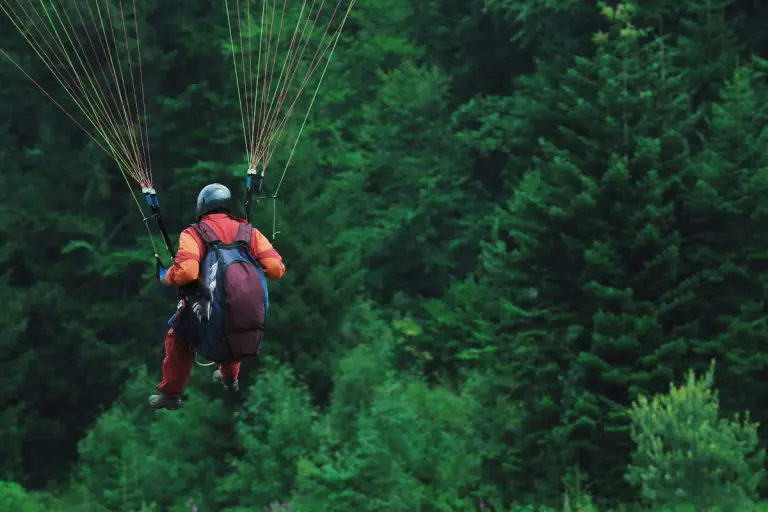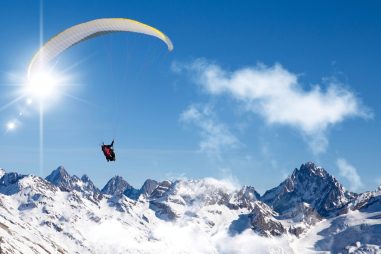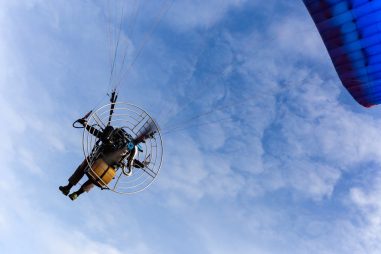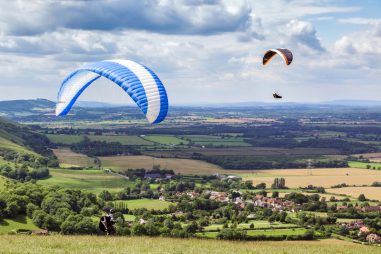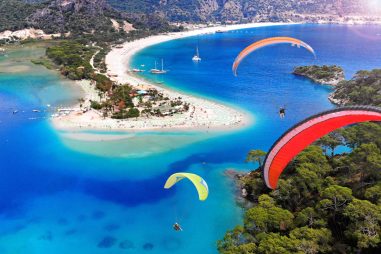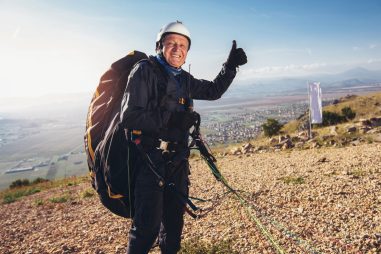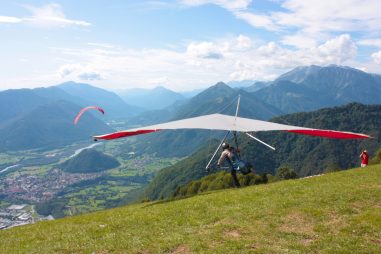All activities carry a significant amount of danger, but these dangers can be avoided by prioritizing safety all the time. There are many pilots who have been paragliding for a long time but have suffered zero injuries or accidents. This is because they act in accordance with the rules and regulations made for paragliding to stay away from harm. Conduct all of your flights with the highest amount of care to always be safe.
Is Paragliding Scary and Fearful?
Paragliding is not that scary as long as you do it the right way to prevent any kind of accident from occurring. There are proper ways to paraglide, and you can even take lessons to educate yourself about this fantastic activity. As a matter of fact, paragliding is a great way to overcome your fear of heights or even fear of flying. Countless people have succeeded in doing so.
A lot of people who have tried this fun sport for the first time say that paragliding offers you a unique sense of tranquility. Some also say that it can be a bit intimidating at first but not exactly scary, and this feeling is followed by calmness and extreme joy. Indeed, paragliding is very pleasurable as it gives you a great opportunity to fly high up in the sky while enjoying beautiful views.
Is There Free Fall in Paragliding?
There is no free fall in paragliding because you will use your wing from the start of your flight until you land. However, there is free flight in paragliding. Free flight is described as making use of the dynamic and thermal lift in sailplanes designed for sustained flight to stay in the air. Free flight is usually done in most aerial sports. The most common ones are hang gliding, paramotoring, and of course, paragliding.
Free falling is done in skydiving wherein one jumps out of an aircraft and falls toward the ground for a while before deploying the parachute. On the other hand, paragliding pilots commonly take off with their paraglider from an elevated height like a slope of a mountain, cliff, or hill. Paragliding is more about making use of air currents to stay aloft, while skydiving is more about falling.
Does Paragliding Feel Like Falling?
Paragliding feels a lot more like flying than falling since your main goal is to stay soaring in the sky for extended hours rather than descending. It is often described by many as the rawest and purest form of flight that gives you a relaxing and peaceful time while enjoying the sceneries. Plenty of people are blown away by how quiet paragliding can be and how it can make them feel like they are one with the skies.
You use your paraglider from the moment you launch until the end of your flight when you land, and it does not involve any sudden drops like in skydiving. The reason why paragliding does not really feel like falling is that you will feel like you are actually flying once your feet are off the ground.
You will be surprised how nicer and calmer paragliding actually is when you are already flying, and the nerves slowly start to fade away.
Is It Safe or Dangerous to Paraglide?
Paragliding is extremely safe compared to other extreme sports as long as you make it a priority to do it the correct way at all times. It is dangerous to paraglide if you do not check your equipment before flying or if you decide to fly in bad weather conditions. Paragliding can be a very dangerous sport if you do not follow the rules and regulations set by authorities and disregard the need for safety.
Technological advancement helped manufacturers design and build better and safer paragliding equipment.
If you take up lessons from a licensed professional instructor, paragliding will be a very safe activity to do. Use what you have been taught in training school to have a smooth paragliding experience.
Just like with any kind of activity you wish to do, paragliding is only as dangerous as you make it, so always remember to keep your guard up the entire time.
How Safe Is Paragliding?
Paragliding is one of the incredibly safest aerial sports that you can try. However, it can get risky if done without sufficient training since this activity comes with a few risks.
You can teach yourself how to paraglide, and many have succeeded in doing so, but it is still best to get proper training from a licensed instructor. Doing this ensures that you know how to use paragliders correctly and know what to do when you encounter obstacles during your flight.
You must always keep in mind to be careful when paragliding to steer clear of unwanted mishaps during your trip. Your safety when paragliding highly depends on your readiness than on external factors that affect your flight. What happens up in the sky is your responsibility because you are the one in control of your flight, so make sure to proceed with utmost caution.
Why Is Paragliding Safe?
The extreme sport of paragliding is safe because the paragliders made nowadays are thoroughly designed to be safe. Various manufacturers produce different kinds of paragliders. These paragliders have been tested, rated, and certified before making them available for purchase in the market. This guarantees that the equipment you buy for paragliding is highly reliable and stable, so it will not cause you any harm.
Equipment malfunctions are very rare when paragliding. However, it would help if you still were very careful, given that they have a likelihood of occurring during your flight. Paragliders built today are designed to help you recover with ease and speed if ever your glider collapses all of a sudden.
Paragliding is both relaxing and fun at the same time. You do not have to worry about a single thing as long as you make it a priority to put safety at the top of your list.
Is Paragliding Safer Than Driving?
According to recorded statistics over the years, paragliding is safer than driving and has a lower fatality rate as well. In fact, paragliding is a lot safer compared to different extreme activities like riding a horse or a motorcycle. Therefore, you do not have to be intimidated by this activity if you want to try it out.
In addition, flying a paraglider is just as safe as flying any other kind of aircraft because it goes on much slower speeds than a car. Paragliding does not really require you to fly at insanely fast speeds, but you still need to reach a certain speed to stay aloft in the air. The extreme sport of hang gliding or speed flying might be better suited for you if you want to try out an aerial sport that involves going at fast speeds.
Paragliding is a safer and more relaxing activity where you soar with the birds high up in the sky while enjoying the landscapes that surround you.
Is There Any Risk in Paragliding?
Similar to any kind of extreme sport, paragliding comes with a few risks, but these risks are certainly manageable. In fact, numerous pilots have gone for decades without suffering any injury or accident of any kind because they always put safety first.
You should always bear in mind to never underestimate the inherent risks of paragliding. Too much confidence that nothing will go wrong during your flight may lead to unwanted accidents.
Risk management is one of the most important lessons that you will be taught in a training school, and you must listen very carefully. Pilots are taught how to manage risks to protect themselves from possible dangers when paragliding. This increases the overall safety of the activity by a great amount.
There is nothing to be scared of as long as you conduct all your flights with extreme vigilance and adherence to safety precautions.
What Are the Dangers of Paragliding?
The dangers of paragliding include suffering injuries or accidents due to negligence to safety. Although unexpected circumstances can still happen, you have the ability to mitigate most of these dangers. Remember to always carry on with utmost care. Listed down below are some of the dangers that paragliding poses when flying in the air:
- Falling
- Oversteering
- Takeoff errors
- Landing errors
- Ground collision
- Faulty equipment
- Deflation of the glider
- Collision with obstacles
- Unsatisfactory preflight checks
- Midair collision with other pilots
- Flying in unfavorable weather conditions
Numerous accidents can happen while paragliding, most especially if it is done in a reckless manner, so you should always be careful. The bulk of paragliding injuries and accidents are due to pilots being uneducated and irresponsible. However, you can do a lot on your part to be a responsible pilot. Educate yourself about the world of paragliding by receiving proper training before taking to the skies.
How Common Are Paragliding Accidents?
The statistics of paragliding accidents are quite blurry, but it shows that they do occur and are very dangerous. It is a little difficult to get a grasp of how common paragliding accidents are because there are various records but really no official record. However, according to some statistics, the accident rate when paragliding is 26 per 100,000 jumps. On the other hand, the injury rate is somewhere around 120 to 360 per 100,000 jumps.
Paragliding accidents are not that common but still happen. Therefore, you should always be watchful of your surroundings to avoid anything that might hurt you. It is absolutely fine to be extra cautious when it comes to participating in extreme activities like paragliding. After all, your well-being always comes first before anything else.
How Do Paragliding Accidents Happen?
Most accidents that happen in paragliding are often due to pilot error brought about by carelessness or too much confidence. External factors out of your control also contribute to the likelihood of accidents happening.
Although equipment failure is rare, it is still possible to occur. Pilots that do not conduct preflight checks will not know if there is something wrong with their paraglider. Failure to do preflight checks may be the cause of an accident to take place.
Paragliding accidents also happen if you still proceed to fly in bad weather conditions even though you are aware that it is unsafe to do so. This is the primary reason why you should always pay attention to safety at all times, no matter what. Here is a list of some of the factors that cause accidents when paragliding:
- Hard landing
- Reverse wind
- Air turbulence
- Abrupt wing closure
- Incorrect alignment of ropes
- Sudden change in weather conditions
Which Injuries Are Common in Paragliding?
Leg, back, spinal, and pelvis injuries are the most common injuries that pilots suffer when they get into an accident while paragliding.
There are many back and pelvis injuries that have been reported, and they are considered to be the most serious on the list. Foot, knee, and ankle injuries are also common, especially in overweight pilots and tandem passengers. This is because they can have a hard time launching, landing, or deploying a reserve.
There are also quite a lot of pilots who sustain upper and lower extremity fractures and are admitted to the hospital for surgery. Patients admitted to the hospital who only suffered minor injuries such as abrasions or sprains are usually discharged right away after getting treated.
According to the reports, most pilots who get into accidents and sustain injuries in aerial sports are males. With that said, make a mental note to proceed with utmost caution all the time to avoid getting into an accident and harming yourself.
Can You Die While Paragliding?
It is possible to die while paragliding, but there are a lot of things you can do on your part to prevent this from happening. Mistakes made by the pilot bring about a large number of paragliding accidents and injuries. Many pilots attempt to execute maneuvers much higher than their current skill level. You must never do this because it is dangerous and can lead to a serious accident.
Paragliding is entertaining and it is an amazing way to let loose after a stressful day. You can do it with your friends and family to strengthen the bond you have with one another. Everyone wants to remember their paragliding trip as a fun time exploring the skies at the end of the day. For this exact reason, you should never neglect safety so you can get back in one piece and experience how enjoyable paragliding is all over again.
What Are the Chances of Dying While Paragliding?
The chances of dying while paragliding is quite low, but you must understand that this sport can still be fatal if done the wrong way. Most accidents and injuries that pilots have to endure are survivable and preventable. As a matter of fact, none of these will ever happen if you do not fail to make observing safety your number one priority.
Most participants of this sport who die while paragliding might have underestimated the potential dangers of this activity. You should not be too confident that nothing will go wrong your whole flight.
Unforeseen events can happen, and they can cause you great harm if you keep your guard down. However, even if there is no way to know when these unforeseen events will sneak up on you, there is so much you can do to shield yourself from them.
What Percentage of People Die From Paragliding?
An in-depth review of recorded statistics shows that the fatality rate of paragliding is 0.0074%. This means there are around 18 fatalities out of 242,355 paragliding flights. The study also shows that 84.2% were male and 15.8% were female. The main cause of these deaths were fractures, major artery injuries, and hemorrhages.
A study made in Fethiye, Turkey, shows a fatality of 7 out of 100,000 paragliding jumps. The numbers were a bit higher in Germany as the fatality rate of paragliding jumps was found to be 45 out of 100,000. The injury rate of paragliding is lower when compared to other adventure and extreme sports. However, the accidents were much more fatal.
How Many People Have Died While Paragliding?
It is impossible to know the exact number of people who have died while paragliding all over the world. Countless deaths are not reported, just like accidents and injuries, so the numbers are quite blurry.
In some countries, there are organizations that keep track of the deaths that happen while paragliding. In spite of that, no one keeps track of all the fatalities that occur, so an official record does not exist.
All you need to know is that paragliding can be fatal if you do it in an irresponsible manner. The construction of paragliders is made to be reliable and stable. It is now in your hands to use the equipment manufacturers made for you with great caution as much as possible.
Never fail to check your equipment before launching. On top of that, always abide by the rules and regulations while you are in the air to keep away from danger.
How Many People Die Annually While Paragliding?
About 1 in 1,000 registered pilots die while paragliding in a year. This is according to the United States Hang Gliding and Paragliding Association (USHPA). Keep in mind that the recorded statistics may vary because many deaths are not reported.
It is difficult to keep track of all the fatalities that happen every year while paragliding across the world. It would require a massive amount of time and effort to accomplish this.
You must always check your equipment if there is anything wrong with it before you carry on with your flight. A huge number of deaths that take place while paragliding is often due to equipment failure or pilot error.
Do your best when assessing the weather conditions to be a hundred percent sure that it is safe to paraglide. Wait for the weather conditions to get better, or just cancel your trip if you see it getting worse. It is better to be extra cautious than to put yourself at great risk.
How Many People Die Each Year From Paragliding in the US?
Around 5 to 10 people die from paragliding in the United States. The numbers are only estimates, so the number of deaths could be higher or lower. It is rather difficult to know how many people die from paragliding each year because the statistics are unclear. Furthermore, many accidents, injuries, and fatalities are not reported, so the records are not accurate.
Manufacturers of paragliding equipment continue to make the designs of paragliders a lot better and safer. They improve the products they put out in the market to make paragliding more protected from danger than it already is. It is now up to you to operate your paraglider in a responsible manner while flying in the airspace. This is one of the many things you can do to avoid the occurrence of tragic deaths in the delightful sport of paragliding.
How to Paraglide Safely?
If you ask a bunch of people who have been paragliding for quite a long time, they will all tell you that the best way to paraglide safely is to get trained by a licensed professional. You will gain a lot of knowledge and wisdom by taking up lessons from a certified instructor that will be, without a doubt, highly beneficial. It will be worth it because there are lots of tips and tricks that you will pick up from your instructor compared to teaching yourself how to paraglide.
You must also never use paragliders or go on flights that are above your skill level because they are more difficult to handle. Your entire flight will be safe as long as you put safety first above all else. It is better to be safe than sorry because all everyone wants is to have a smooth, fun, and relaxing flying experience at the end of the day.
What Does SIV Stand for in Paragliding?
SIV stands for “Simulation d’Incident en Vol” in French, which translates to “Simulated Incident in Flight” in English. SIV means simulating unstable situations in flight.
There are SIV Courses you can take up. A certified instructor will teach you how to recover from possible incidents that can happen while paragliding. You will learn how to take control of the situation with a calm mind to get your glider back to flying normally if a collapse or spin happens.
It is not necessary to take an SIV Course, but many pilots strongly recommend that you do if you plan on increasing the intensity of the flights you go on. An SIV Course will benefit you in many ways. It gives you the ability to control your wing in extreme turbulence and fly in different strenuous conditions.
If you have second thoughts about signing up for an SIV Course, know that you should certainly do so because it is highly advantageous.
What Is a Paragliding SIV Course?
A paragliding SIV Course is an advanced flying course for paraglider pilots. It covers an incredibly broad range of lessons to help you fly a lot better and safer.
An SIV Course is of tremendous help because it teaches you how to deal with unpredicted situations you might face while flying. You will learn the fundamentals of wing control and how to recover with great ease in the event of a collapse, spin, or other unexpected scenarios.
You get hands-on experience if you take an SIV Course, and you will learn how to anticipate events while flying using your instincts and facts combined.
In addition, you can also enroll in SIV Clinics to improve your overall flying capabilities and develop new skills while simultaneously increasing the level of your safety during flight. Therefore, it is worth it to take an SIV Course because it goes beyond theory, and it will be very useful in your paragliding trips.
What Is the Safest Paraglider?
The safest paraglider is one that has been tested, rated, and certified that it is reliable and stable. It should be able to support your weight, provide you maximum comfortability and give you excellent performance without compromising your safety.
Manufacturers of paragliders are able to make better and safer equipment thanks to the continuous advancement of technology.
You should understand that your safety is relative. Countless factors affect the level of your safety while flying. The weather conditions, your capabilities, and your decision-making skills are some factors that impact your overall safety when you are in the air.
You may use the safest paraglider ever constructed but you would still be unsafe if you fly in a reckless manner with no care for safety.
In no specific ranking, here are some of the safest paragliders you can use:
- Spyder 3
- Ozone Atom 3 M
- Ozone Mojo Power
- Ozone’s Roadster 3
- Pappillon Bodyguard 7
- Skywalk Mescal 4 M
- UP Aszent 4 M
- UP Makalu 3 M
- Mcpara Eden 7
- Nova Mentor 6
Can You Paraglide With an Instructor?
You can paraglide with an instructor as long as you are in good health. However, you must make an effort to ensure that they are experienced and licensed, to be safe.
Tandem flights use a bigger wing for carrying two people wherein the passenger is strapped in a separate harness in front of the pilot. Your instructor will give you a short briefing beforehand on how to take off and land as well as what to do and not do throughout the duration of your flight.
Tandem flights are a great way to experience paragliding. It will surely give you a fun time that will take your stress away from the daily worries of the world. Your instructor may even allow you to take control of the flight for a few minutes if you are capable and if the weather conditions are good.
If you only desire a relaxing time admiring the breathtaking views from thousands of feet above the ground, this is the way to go.
How Safe Is Paragliding With Instructor?
Paragliding with an instructor who is qualified and has certifications is incredibly safe, so you do not have to worry about anything.
Paragliding comes with a few risks, but it is still a very safe activity as long as you follow the rules and regulations that were made for your own good. Most tandem flights with an instructor are short as they only last for a few minutes up to an hour but give you an unexplainable feeling of extreme joy.
If you are considering paragliding with an instructor, make sure that you trust them. You should be comfortable taking to the skies for a good few minutes with them. There is no problem at all if you want to find a different instructor that you have faith in rather than flying with someone you are not comfortable with. After all, no one wants to worry when the main goal is to have a pleasurable and calming time soaring through the skies.
What Are the Safety Measures of Paragliding?
The safety measures of paragliding involve making a few checks here and there to guarantee that the entire duration of your flight will be safe. A successful flight starts with a smooth takeoff, a crazy fun time in between, and ends with a safe landing. Here are some safety measures you should do before and during paragliding to be safe at all times:
- Use appropriate equipment: Always ensure that you are using the right equipment when paragliding. Failure to do so may result in a series of unfortunate events full of disappointment. On top of that, using the wrong equipment may also lead to serious injuries or severe accidents.
- Use a suitable wing class: You must use a paraglider with a wing that suits your level of experience. Paragliders that have a higher wing class are more difficult to handle. Start with using equipment made for beginners and slowly move to more advanced ones over time.
- Inspect paragliding equipment: Do not forget to check your equipment before each one of your flights, whether you are a newbie or not. Your paraglider might be defective, and it is very dangerous to fly with damaged equipment. This is something that you must never skip no matter what happens.
- Assess weather conditions: Evaluate the weather conditions if it is safe to fly before taking to the skies. Do not fly if there is heavy rain, excessive lightning, extreme fog, or powerful winds. These weather conditions are unsafe and will most likely result in an accident.
- Maintain safe distances: You should always ensure there is enough space between you and other pilots flying in the sky. There is a possibility that you might crash into one another if you are in close proximity.
- Conduct site assessments: Always perform site assessments whether you are flying in a familiar area or a new one. There might be obstacles or hazards that could block your path. See what the air traffic looks like and search for a few emergency landing options if ever you might need to use one.
- Make a checklist: List down all the things you need to bring with you on your flight to be sure that you do not forget anything important. You can also list down everything you need to check before flying, like your equipment or gear. This will guarantee that your paragliding experience will be safe, free of troubles, and lots of fun!
- Buy quality gear: Do not skimp out too much when buying paragliding gear. It is certainly okay to be a little frugal if you are on a tight budget as long as you still get quality gear for a lower price. There is a world of difference when using gear that is reliable and of excellent quality.
- Wear your gear properly: Put effort into making sure that your helmet, gloves, harness, buckles, and straps are secured. You do not want anything falling off in the middle of your flight as it might harm you or other pilots in the air. Always check your gear every time because they offer you protection throughout your entire adventure.
- Obey rules and regulations: There are rules and regulations put in place by authorities. This ensures your safety and those that surround you when flying. You must follow these rules and regulations all the time. On top of that, you must also give way and be respectful to other people in the sky.
Do Paragliders Wear Parachutes?
Paragliders wear parachutes as a safety precaution in case an unexpected problem arises in the middle of their flight. They do not actually wear the parachute. It is just attached to their harness, ready for deployment when it is needed. However, even advanced pilots make mistakes, and it is not certain that nothing will go wrong while you are high up in the sky. This is why you must have a parachute you can rely on for your peace of mind.
You reach high altitudes of up to 18,000 feet (5,500 meters) or more when paragliding, which would be quite a fall. This alone is enough reason why you should never forget your parachute when going on a paragliding adventure.
Whether you are a beginner or an experienced pilot who has been flying for a long time, you must never launch your paraglider without a parachute. It is very dangerous to go on a flight without a parachute because you will not have anything to save you if your equipment fails all of a sudden.
What Is a Reserve in Paragliding?
A reserve or a reserve parachute in paragliding is just another term for your backup parachute, which you use in case of an emergency.
It does not matter how good or experienced you are in paragliding, you must never forget to bring a reserve parachute with you. Accidents may happen without warning. There is a possibility that your wing will deflate or your equipment will malfunction when paragliding. A reserve parachute comes in handy during these times.
There are many different kinds of reserve parachutes, and choosing the perfect one that suits your needs can get a little challenging.
Reserves come in different designs, qualities, and construction. This affects how efficient and effective they are. Therefore, you must figure out what kind of flying you intend to do before buying a reserve parachute to make sure you pick the right one. That said, here are the various types of reserve parachutes that you can choose from:
- Pulled-Down Apex (PDA): This design of reserve parachutes is the most popular. Many paragliders use it more through the years. The only con is that it can be a bit unstable during descent because it is heavier and bigger. However, many paragliders trust this type of reserve because it is reliable, simple, and cheap.
- Cruciform (Square): Reserve parachutes of this design are priced a little higher. Cruciforms have vents in their corners. This allows it to track sideways and provides you with an excellent stability and sink rate. It is more compact, but it is not steerable, so you have no control over where you will land.
- Square-Round (SQR): This hybrid square-round reserve parachute mixes the features of PDAs and cruciforms along with other design innovations. It has a lower volume, weighs lighter, opens faster, and offers a much steadier descent. Although it is also unsteerable, square-round reserves are easy to pack and use.
- Rogallo: There are many advantages when you use a rogallo reserve parachute which is why many paragliders also prefer this design. It has the best descent rate compared to other designs, offers high stability, and opens a lot quicker. On top of that, it is also steerable, so you can steer into clear airflow to decrease ground speed and landing impact.
- Ram-Air: This kind of reserve is perfect for those who love acrobatic paragliding because of its cutaway system. It is fully steerable and deploys the fastest, which lets you reduce landing speed and reach the ground safely even if there are strong winds. However, it is sold at a high price, and it is extremely complicated to pack.
What Size Reserve Parachute Do You Use for Paragliding?
Your all-up flying weight determines the size of the reserve parachute that you use for paragliding. Like the wings you use in paragliding, reserve parachutes have weight ranges as well.
It is crucial to be sure that your reserve parachute can support your weight throughout the entire duration of your flight. You descend faster if your reserve has a heavier load when flying. You should not go over a sink rate of 5.5m/s (1083 fpm) because you will be more prone to sustaining an injury on landing.
A reserve should not be too big because it will result in oscillation problems, and you will swing violently from side to side. It should also not be too small because you will go down faster and might suffer from a hard landing.
Reserves will specify a maximum load, and manufacturers typically indicate a weight range. Many companies produce different kinds of reserve parachutes. Do your research and take your time in selecting one that meets your needs and wants for an enjoyable and protected flight.
How Much Is a Paragliding Parachute?
The average price of a paragliding parachute ranges from about $600 to $1,300, depending on its size and quality. Of course, it will be more expensive if it is bigger and has high-quality materials used in its construction.
You can find a paragliding parachute available for purchase in the market for as low as $400. However, the advanced and better ones can go as high as $1,400 or even more if you buy from a famous brand.
If you are new to paragliding, it is crucial to understand that you must never take to the skies without bringing a parachute.
Do not be too frugal when buying a parachute because it is something you should be able to count on if something goes wrong mid-flight. It is better to spend a few extra bucks to have good quality and reliable parachute when your equipment fails on you all of a sudden.
With that said, you have the option to buy secondhand parachutes from other pilots or a trusted friend if you are on a tight budget. You just need to make sure that it is maintained well and in excellent working condition.
How Long Does a Paragliding Reserve Last?
A reserve parachute for paragliding usually lasts for ten years. Your parachute will be more porous and less reliable as it ages. Almost all paragliding equipment manufacturers recommend changing your reserve parachute every ten years.
Although that may be the case, a reserve parachute may last twelve years or even more if it is well taken care of. Do your best never to get your reserve wet or store it damp to avoid damaging it. In addition, also make sure that it is free of any kind of contamination like dirt, dust, sand, or even insects.
The life of your reserve parachute will last for a shorter time if you go on paragliding trips often and deploy your parachute a lot. This is because the materials used to build your parachute will deteriorate faster with frequent exposure and use. Therefore, have your parachute inspected every year or once every six months if you paraglide regularly. Doing this will ensure that your parachute is maintained well, thereby making it last much longer.
How Do You Throw Your Reserve When Paragliding?
Throwing your reserve parachute is not that hard, but panic might get the best of you if you are on a spiral dive. A disastrous collapse can happen when you are paragliding due to a lot of factors that can impact your flight. Here is a detailed step-by-step guide on how to throw your reserve parachute if you ever find yourself in a tight spot while paragliding:
- Assess the situation: Make a quick assessment of the situation you are in before throwing your reserve parachute. Do not hesitate to use your reserve parachute if you find the situation you are in is getting worse. This will save your life.
- Locate your reserve: Once you have made up your mind, find where your reserve is. Reserve parachutes are usually kept inside a pocket or container attached to your harness. It may be on your left or right side, depending on where you mounted it.
- Prepare to throw: After finding where your reserve parachute is, get ready to throw it. Reach down to the container and hold on tight to the handle of your reserve parachute. This may be a bit of a challenge if you are in a spiral dive.
- Pull the handle: Once you have the handle of your reserve parachute in a tight grip, pull it. You may be able to deploy your reserve by performing an uninterrupted outward pull. Let go of the handle when your arm is stretched out all the way.
- Throw the reserve: Find a clear spot and throw your reserve away from your body with great power. Make sure that there is no obstruction where you decide to throw your reserve parachute. Stop the rotation before throwing your reserve as much as possible.
- Check your reserve: The moment you succeed in throwing your reserve parachute, check if it is deploying the right way. It may need a slight tug to make it open. Keep your eyes focused on your reserve while keeping your guard up until it is open.
- Disable your glider: Your reserve parachute will pull you back as soon as it inflates. Your glider will go straight to the ground because you have very little forward flying speed. You will be caught between the two pieces of equipment, so you must disable your glider.
- Keep your legs down: You might suffer a hard landing if you descend at a fast speed. Keep your ankles together with your knees bent a little. Turn your body and feet at a slight angle to the direction of impact (45 degrees). Present your calf to the ground first, followed by your thigh and then your hip. Afterward, tuck your torso in and stretch out your legs as you roll onto your back.
- Disable the reserve: Run towards your reserve and pull the harness in as soon as you stand up. Your reserve parachute may drag you, and your main glider may pull on you as well if the wind is strong. Get your hook-knife ready if ever the situation becomes too difficult to control. You also have the option to unclip from the harness.
Familiarize yourself with the equipment you plan to use in paragliding. Some harnesses require a great deal of muscle power to release the reserve. If your harness has velcro closures, it may also become tightly bonded if you do not have it inspected regularly. Always keep in mind to proceed with extreme caution with everything you do while paragliding to be protected from harm all the time.
What Other Precautions Should Be Taken While Paragliding?
Always have an alert mind while paragliding to avoid crashing into other pilots or obstacles in the airspace. Check your equipment if it is in excellent working condition before you take off to make sure that it will not fail on you in the middle of your flight. Conduct launching and landing site assessments to be aware of any hazards that could block your path.
You should never underestimate the dangers that come with paragliding. You will be more vulnerable to accidents and injuries if you do not observe safety all the time.
Acquiring proper training from a licensed instructor will benefit you in many ways. This may be the most important safety precaution you must do beforehand if you want to explore the heavens.
Paragliding is a ton of fun, but you should never soar in the skies without sufficient knowledge and experience. You must take it upon yourself to educate yourself about the wonderful sport of paragliding ahead of time to stay safe at all times.
Should I Be Afraid of Paragliding?
You should not be afraid of paragliding because it is a very controlled activity even though it is an extreme sport that carries some risks. There is nothing to be scared of if you take up paragliding lessons under the guidance of a certified instructor.
It is normal to feel intimidated if it is your first time paragliding, but most people say that it is actually relaxing once you are already flying. The nerves will begin to go away little by little after a few minutes.
Paragliding is safe as long as you do your best to obey the rules and regulations when flying in the air. Never attempt to do maneuvers higher than your skill level, as this could result in a severe accident. The majority of accidents that happen in paragliding are often due to pilots being careless or external factors out of their control. Your flight will be free from danger if you put safety first at all times.
How Do I Get Over My Fear of Paragliding?
You can go on a few tandem flights with a licensed instructor whom you trust if you are scared but have a strong desire to try out paragliding. It is a wise idea to work on your fear first with a companion before attempting to go on a solo flight. It can be very dangerous to fly on your own if you are not confident enough in your skills. This may lead to panic that will cause you to lose control of your paraglider and result in unwanted accidents or injuries.
It is also helpful to understand that there is something you can do to overcome the fear you are feeling. Trust yourself and have positive thoughts rather than negative ones. Instead of thinking that you will fail on your flight, think of the indescribable happiness you will feel after a triumphant flight. Paragliding is a pleasurable and amazing activity. It is definitely worth trying out!

